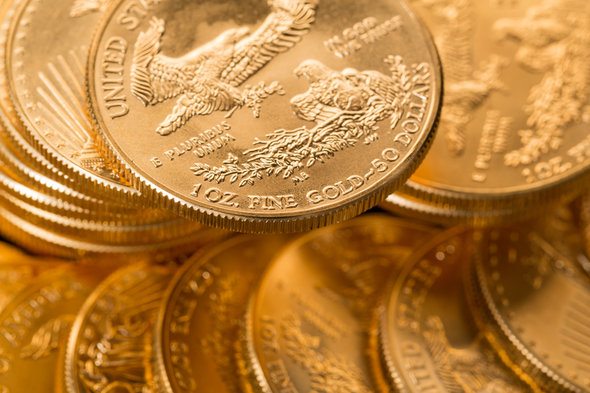A gold IRA is one way to save for retirement. As its name suggests, instead of stocks or bonds, it holds gold in the form of bars, coins and bullion. It can also hold other precious metals like platinum and silver. Typically, people who have a gold IRA are looking to diversify their assets and hedge against inflation. But given that gold has no earnings while sitting in your custodian’s safe, there is little advantage in putting it in an IRA, whose main feature is tax deferral on earnings. However, it may make more sense to diversify your portfolio and hedge against inflation with other holdings. A financial advisor can help you strategize and implement a plan.
What Is a Gold IRA?
With a traditional or Roth individual retirement account (IRA), you invest your savings in the form of stocks, bonds, mutual funds and other securities. With a gold IRA, which can be traditional or Roth, but must be self-directed, your account holds gold in the form of coins, bullion or bars. You can also own other precious metals like silver, platinum and palladium in your gold IRA. When it comes to IRA contributions, disbursements and taxes, gold IRAs follow the same rules and procedures as other IRAs.
Many gold IRA account holders also choose to invest in other gold-related investments called “paper assets.” These include stocks and exchange-traded funds (ETFs) in gold mining companies, precious metals commodity futures or precious metals mutual funds. Note that this is rare, though, as most gold IRAs strictly consist of physical metal investments.
What Precious Metals Are Eligible for Gold IRAs?
Not all gold or other precious metals will qualify for inclusion in an IRA. The metals you want to invest in will have to meet fineness standards established by the IRS. Specifically, gold must be 99.5% pure, silver must be 99.9% pure and platinum and palladium must be 99.95% pure. Here’s a general breakdown as to what your gold IRA can include:
| Type of Metal | Examples of Eligible Coins and Bullion |
|---|---|
| Gold | – Certain bars and bullion produced by a national government mint or an approved refiner – American Eagle coins – Uncirculated Gold Buffalo coins – Canadian Maple Leaf coins – PAMP Suisse bars – Austrian Philharmonic coins – Australian Kangaroo/Nugget coins |
| Silver | – Certain bars and bullion produced by a national government mint or an approved refiner – American Eagle coins – Canadian Maple Leaf coins – Australian Kookaburra coins – Mexican Libertad coins |
| Platinum | – Certain bars and bullion produced by a national government mint or an approved refiner – American Eagle coins – Canadian Maple Leaf coins – Australian Koala coins – Isle of Man Noble coins |
| Palladium | – Certain bars and bullion produced by a national government mint or an approved refiner – Canadian Maple Leaf coins |
There are a number of precious metals that are not allowed in gold IRAs. Principal among these are collectible coins, such as graded or certified coins. Additionally, the following metals are deemed unacceptable:
- Austrian Corona
- Belgian Franc
- British Sovereign and Britannia
- Chilean Peso
- Dutch Guilder
- French Franc
- Hungarian Korona
- Italian Lira
- Mexican Peso
- South African Krugerrand
- Swiss Franc
How to Open a Gold IRA

In order to open a gold IRA account, you have to select a custodian to hold the assets for you. This is because the gold must go into an IRS-approved depository and not just a regular savings account. You can call your nearest bank, credit union, trust company or brokerage firm to find an approved custodian for your gold IRA.
Of course, you’re going to want a custodian you can trust with your gold, so look around before committing. Keep an eye out for companies with a long history of holding gold IRAs and physical assets. Custodians with a good track record can also help you create a relationship with precious metals dealers. Check out customer reviews to see how each company has performed when it comes to various customers’ needs. Don’t forget to weigh the fees of each custodian, since setting up a gold IRA will include various charges.
Gold IRA Fees and Costs
Opening and maintaining a gold IRA usually comes with more fees than a traditional or Roth IRA. Since gold must be stored in an IRS-approved depository, you will pay annual storage fees. Custodians also charge account setup fees, transaction fees when buying or selling metals and annual maintenance fees. These costs can add up quickly and may erode your investment returns over time.
Unlike a brokerage IRA where you might only pay trading commissions or fund expense ratios, a gold IRA requires you to budget for ongoing physical storage and insurance of the metals. Depending on the custodian, annual costs can range from a few hundred dollars to more than a thousand.
Because gold IRAs don’t generate income through dividends or interest, these fees are paid directly out of your pocket or deducted from the account, which reduces the value of your holdings. Comparing fee schedules across custodians is critical before opening an account.
Here’s a simple breakdown of typical gold IRA costs:
| Fee Type | Typical Range |
| Account Setup | $50 – $300 (one-time) |
| Annual Maintenance | $75 – $300 per year |
| Storage Fee | $100 – $300 per year (segregated storage often costs more) |
| Transaction Fees | $40 – $50 per purchase or sale |
| Wire Transfer Fees | $25 – $30 per transaction |
Factoring these costs into your decision will help you determine whether a gold IRA makes sense compared to other retirement investment strategies.
Pros and Cons of a Gold IRA
During major market downturns, gold has historically moved in the opposite direction of stocks. During stronger markets, gold and stocks may move more closely together. Gold can serve as a hedge against market volatility and inflation since its value often rises when the dollar weakens.
Although equities can provide some protection against inflation, fixed-income investment like bonds tend to lose purchasing power during inflationary periods. Bonds are generally considered safe for retirement portfolios, but if inflation risk is a concern, allocating a portion of savings to gold could provide additional balance.
That said, a gold IRA has drawbacks. There are notable upfront costs to set up and maintain a gold IRA. In addition, gold does not pay dividends or interest, which limits the tax advantages typically associated with an IRA. Gold is also less liquid than other investments, which can make required minimum distributions (RMDs) harder to manage in retirement.
It’s also important to note that gold IRAs are subject to the same annual contribution limits as other IRAs—$7,000 for those under age 50 and $8,000 for those 50 or older in 2025. These limits apply across all IRA accounts combined, so if you’re already contributing to a traditional or Roth IRA, your ability to add funds to a gold IRA may be limited.
Bottom Line

A gold IRA can help diversify your retirement portfolio and protect savings during periods of market volatility or high inflation. However, it’s important to research carefully before opening one to understand the costs, rules, and limitations. Make sure a gold IRA fits your overall retirement strategy before choosing a custodian to hold your gold.
That said, some experts caution that the drawbacks may outweigh the benefits.
“The fees associated with maintaining a gold IRA are usually not worth the potential benefits,” said Tanza Loudenback, a Certified Financial Planner™ (CFP®). “There are other ways to get exposure to precious metals that can help counterbalance inflation, if you’re worried about that, and are generally more investor-friendly, like gold ETFs.”
Tanza Loudenback provided the quote(s) used in this article. Please note that Tanza is not a participant in SmartAsset AMP, is not an employee of SmartAsset and has been compensated. The opinions voiced in the quote(s) are for general information only and are not intended to provide specific advice or recommendations.
Planning for Your Retirement
- Finding a financial advisor doesn’t have to be hard. SmartAsset’s free tool matches you with vetted financial advisors who serve your area, and you can have a free introductory call with your advisor matches to decide which one you feel is right for you. If you’re ready to find an advisor who can help you achieve your financial goals, get started now.
- Mutual funds are another good option for retirement investments.
Photo credit: iStock.com/MachineHeadz, iStock.com/BackyardProduction, iStock.com/inhauscreative
